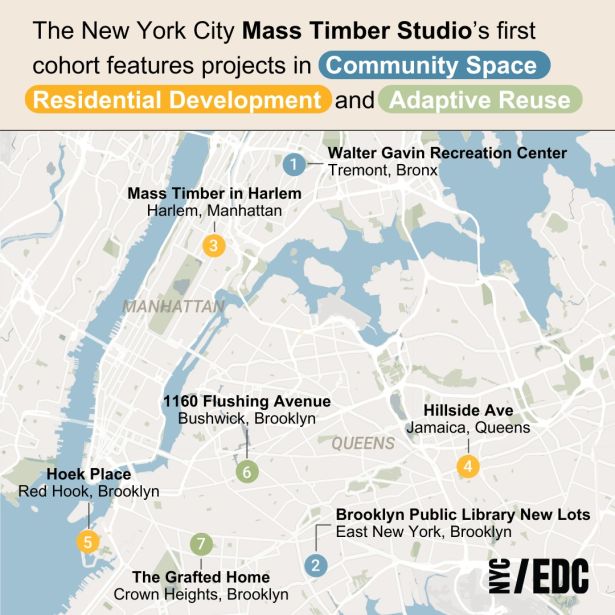[ad_1]
New York City wants to bring eco-friendly construction to the masses and started that journey by picking seven projects to participate in a new mass timber incubator.
The first projects in the New York City Economic Development Corporation’s (EDC) “Mass Timber Studio” run the gamut from the New Lots branch of the Brooklyn Public Library to an affordable housing development in Jamaica, Queens, spearheaded by MURAL Real Estate Partners and Curtis + Ginsberg Architects, Commercial Observer has learned.
Projects in the nine-month incubator will get technical support from several city agencies as well as other experts on mass timber construction, including the Wood Products Council and the American Institute of Architects New York. Plus, they’ll each get a $25,000 grant for their efforts.
“For a developer or design team to put themselves through a nine-month studio with us, our expectation is that all of them will be able to go to the finish line,” said Cecilia Kushner, the EDC’s chief strategy officer. “We already know that these projects can be permitted, so they will not have any issue on that front.”
The EDC launched the mass timber incubator in September in an effort to move buildings away from traditional construction materials like concrete and steel to the low-carbon alternative of pressurized wood. The agency received only 10 applications but selected these projects because of their feasibility, geographic diversity, and ties to local environmental justice communities across the boroughs, Kushner said.
The participants include Hoek Place, a five-story residential building in Red Hook, Brooklyn; Mass Timber in Harlem, a seven-story apartment building; 1160 Flushing Avenue, an industrial development in Bushwick, Brooklyn; The Grafted Home, a three-story residential building in Crown Heights, Brooklyn; and the Walter Gladwin Recreation Center, a public facility in the Tremont neighborhood of the Bronx.

Even with the relatively small scale, the EDC hopes the pilot will help New York catch up with cities on the West Coast and in Europe that have started to embrace mass timber construction.
“It’s really just making sure that more New Yorkers in the building construction trade have firsthand experience with it,” Kushner said. “It’s really a game of numbers and scale.”
To get the incubator started, New York City had to amend its building code to allow for cross-laminated lumber — the pricey raw material behind mass timber — to be used as a structural element.
Aside from the cost and building code restrictions, the lack of familiarity with mass timber has also been a huge disincentive for contractors in the city to use it, said Justin Den Herder, a structural engineer with Silman Structural Solutions who is working on three of the projects in the incubator.
“It’s a big step forward to integrate mass timber into buildings,” Den Herder said about the program.
Part of that step stems from design and construction teams discussing challenges they encounter with the New York City Department of Buildings when using mass timber. Sharing information can make it easier for others to file permits down the road, Den Herder said.
“What obstructions are they encountering in implementing mass timber? What questions do they have about its benefits?” he said. “We will share across projects with the goal to disseminate that information so more builders can follow this path.”
In addition to the mass timber studio, the EDC has other plans up its sleeve to green the city’s building trades.
The quasi-public agency also started its Circular Design and Construction Guidelines on Thursday, a template for lowering carbon emissions throughout the process of designing and constructing buildings. It will soon seek proposals for projects to follow the guidelines and also divert 75 percent of their construction materials from a landfill, among other environmental goals.
The new guidelines are already being put to work in the development of a 2 million-square-foot life sciences hub at SPARC Kips Bay, which the city said would reduce 26,400 metric tons of carbon emissions, Mayor Eric Adams announced last week.
EDC President and CEO Andrew Kimball said in a statement that the construction guidelines and mass timber studio are both part of the same “bold action” plan.
“If we want to decarbonize our built environment and lower our carbon emissions, it is critical we prioritize the scaling of the clean construction industry,” Kimball said.
Abigail Nehring can be reached at anehring@commercialobserver.com.
[ad_2]
Source link


